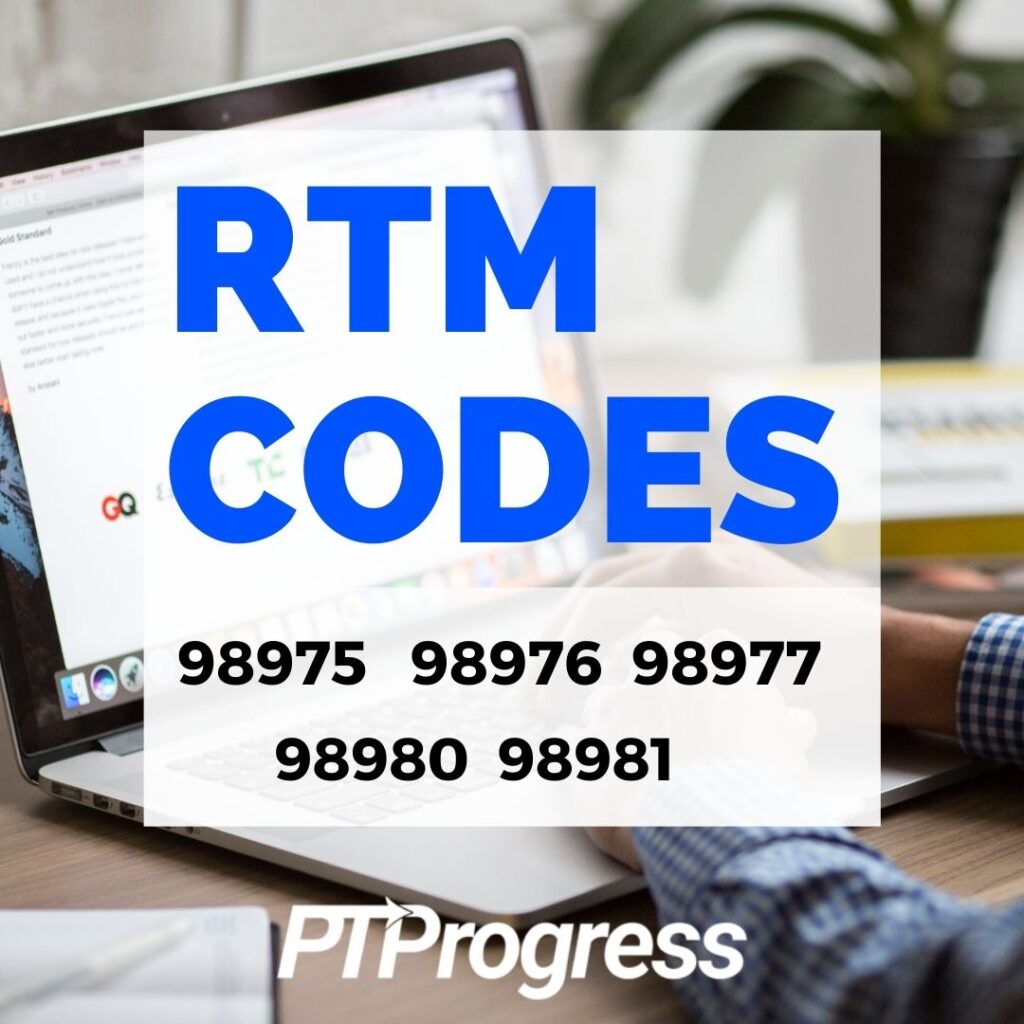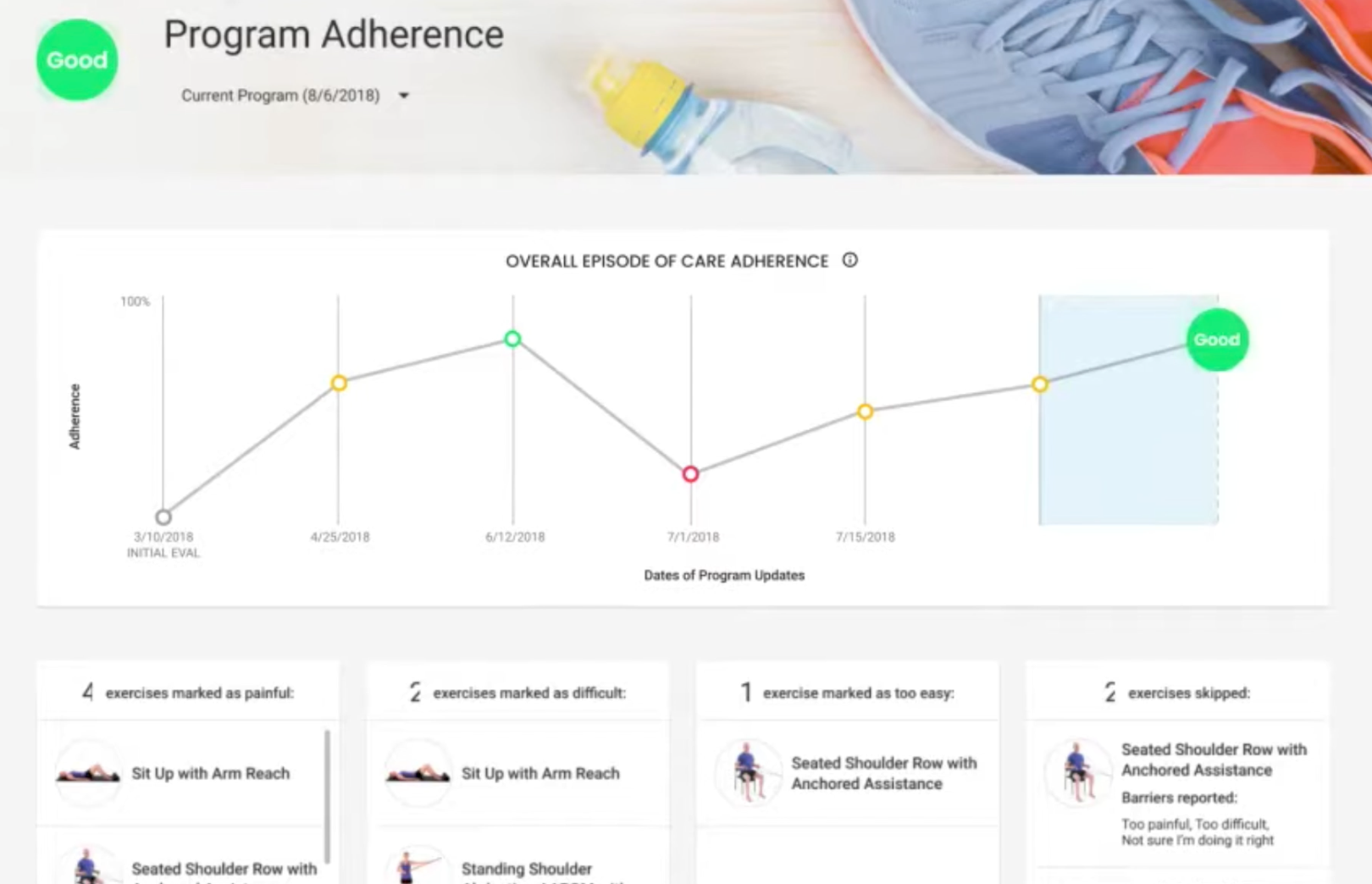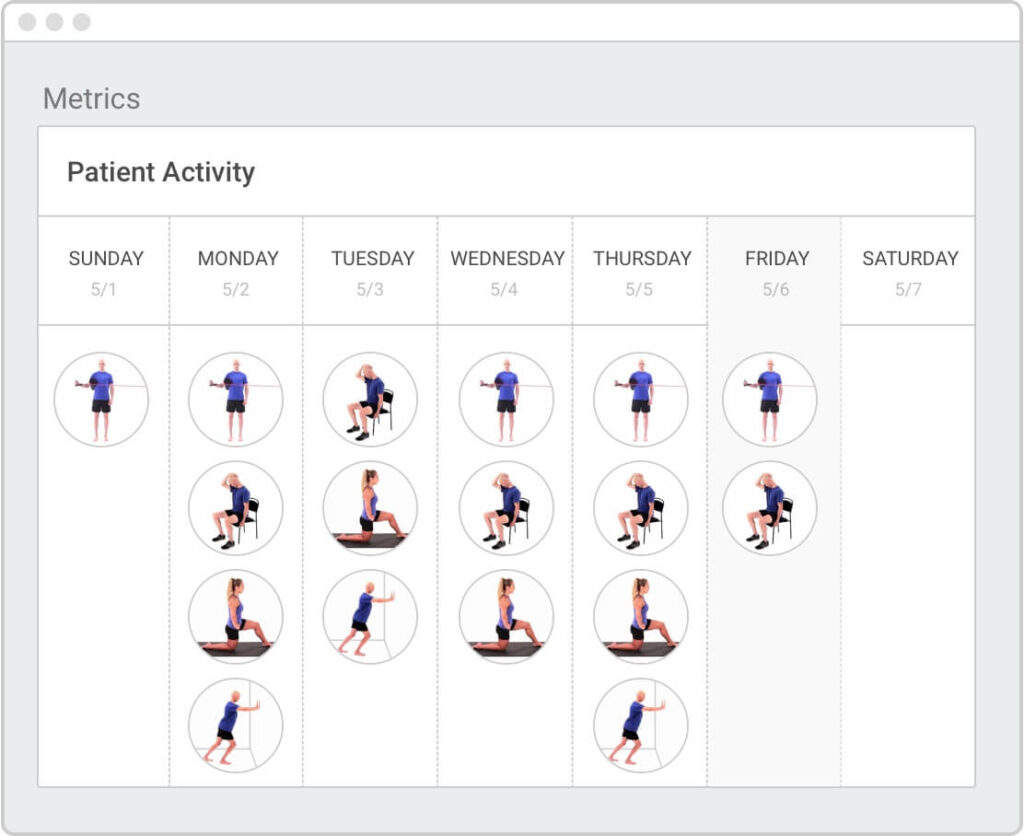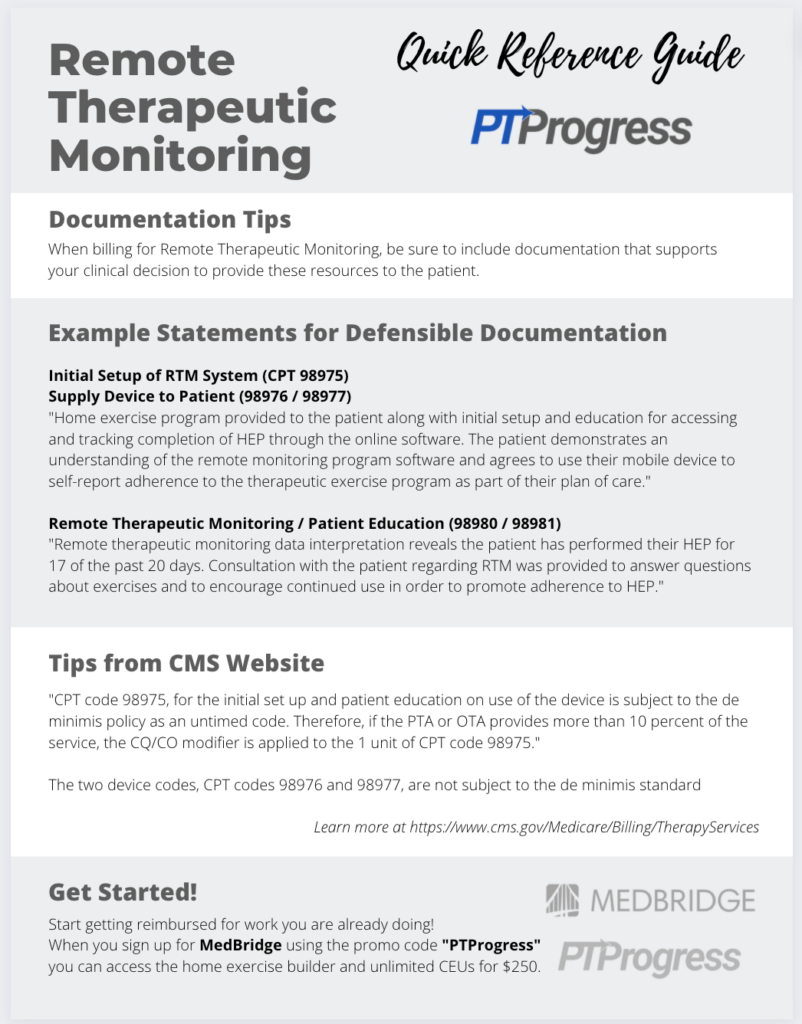
Medicare just released the new Physician Fee Schedule on RTM Codes or Remote Therapeutic Monitoring. These new CPT codes could lead to thousands of additional dollars in reimbursement for PT and OT clinics without them having to do anything more than monitoring home exercise program compliance through a simple smart app.
Today I will explain the RTM codes and show you how you can get started right away with a tracking tool that you may already be using in your clinic.
What are RTM Codes?
CMS approved 5 new CPT codes for Remote Therapeutic Monitoring (98975, 98976, 98977, 98980, 98981). These are different from RPM codes or remote patient monitoring in that RTM codes do not require tracking of physiologic data. In fact Remote Therapeutic Monitoring codes were specifically designed to track non-physiologic data related to the musculoskeletal or respiratory system. It also includes monitoring the adherence and response to therapy, including home exercise program compliance.
5 Remote Therapeutic Monitoring Codes
CPT 98975
CPT code 98975: (Remote therapeutic monitoring (e.g., respiratory system status, musculoskeletal system status, therapy adherence, therapy response); initial set-up and patient education on use of
equipment) *quoted from CMS Fee Schedule
What Does That Mean?
CPT Code 98975 is used for initial setup of a monitoring system as well as patient education for using the device or equipment. Medicare provides a one-time reimbursement of about $20 for this code per episode of care. Satisfying this in the clinic can be as simple as sending a HEP to your patient where they can access their exercises through an online platform and track their progress. Tracking needs to be in place for at least 16 days to qualify for reimbursement, so keep this in mind as you want to make sure you satisfy this requirement for Remote Therapeutic Monitoring.
CPT 98976
CPT code 98976: (Remote therapeutic monitoring (e.g., respiratory system status,
musculoskeletal system status, therapy adherence, therapy response); device(s) supply with
scheduled (e.g., daily) recording(s) and/or programmed alert(s) transmission to monitor
respiratory system, each 30 days) *quoted from CMS Fee Schedule
CPT 98977
CPT code 98977: (Remote therapeutic monitoring (e.g., respiratory system status, musculoskeletal system status, therapy adherence, therapy response); device(s) supply with scheduled (e.g., daily) recording(s) and/or programmed alert(s) transmission to monitor musculoskeletal system, each 30 days). *quoted from CMS Fee Schedule
What Does That Mean?
CPT Codes 98976 and 98977 are nearly identical except 98976 is for monitoring respiratory system and 98977 is for monitoring the musculoskeletal system. Most PTs/OTs are going to use 98977, which reimburses you about $55 per person per month (really a 30 day period). Medicare allows patients to provide self-reported data which can be collected and transmitted via Software as a Medical Device. In other words, patients can use their own cell phones to submit data via the HEP software you are providing them access to, which may count as Software as a Medical Device. Again, you want to make sure to only submit this code when you have met 16 days of monitoring data in a 30 day period.
CPT 98980
CPT Code 98980: Remote therapeutic monitoring treatment, physician/other qualified health care professional time in a calendar month requiring at least one interactive communication with the patient/caregiver during the calendar month; first 20 minutes *quoted from 2022 Fee Schedule
CPT 98981
Remote therapeutic monitoring treatment, physician/other qualified health care professional time in a calendar month requiring at least one interactive communication with the patient/caregiver during the calendar month; each additional 20 minutes *quoted from CMS Fee Schedule
What Does That Mean?
The last two CPT Codes 98980 and 98981 have to do with managing the RTM data. Medicare will reimburse a therapist for monitoring and communicating with the patient about the data collected remotely. The first code 98980 covers the first full 20 minutes that a provider consults with the patient and the CPT code 98981 is used for each additional full 20 minutes of consultation with a patient during a calendar month. CPT 98980 reimburses the clinician about $50 and 98981 reimburses an additional $40 for each additional full 20 minutes spent consulting with the patient about the data.
How to Start Using RTM Codes in the Clinic
Now this is where it gets fun because every PT and OT that I’ve ever worked with prescribes home exercise programs. If you’re like me and you’ve been using a program like MedBridge to assign your home exercise program – you’re in luck because everything may already be set up for you to start using the new RTM codes.
For clinics using the MedBridge Enterprise solution, you have access to the HEP+ program. This allows your clinicians to use the MedBridge HEP Builder and the free MedBridge GO app for patients which provides access to their exercises. Clinicians can track patient adherence to the exercise programs and also receive patient feedback directly through the app. As the provider, you can simply log into your dashboard and view how many times they’ve accessed the program and track compliance, satisfying the monitoring requirements for the new CPT codes.

Medicare simply requires that you monitor adherence through a remote tracking device. On your dashboard, you can easily see how many times your patient has logged into their HEP and use this data to support your use of RTM codes through documentation.
All of this is included in the MedBridge Enterprise solution. If you’re a clinic owner wanting to implement RTM codes without signing up for expensive recurring monthly plans of other home exercise apps, consider giving each of your therapists access to MedBridge through the Enterprise solution which provides them with access to earning unlimited CEUs and also access to the HEP builder as part of their premium access.

Financial Impact of Remote Therapeutic Monitoring (RTM Codes)
MedBridge will practically pay for itself after using RTM codes with two patients. And since most PTs treat more than two patients each month, that means your clinic is going to benefit in a huge way financially. I personally pay for a single license each year for just $250 using the promo code PTProgress, and it pays for itself based solely on the continuing education I earn.
Here’s an example of how it might look for one patient who is coming to PT for treatment.
Day 1 – Evaluation, treatment, and setup RTM
RTM code 98975 is about $20 per episode of care, but requires 16 days of monitoring in order for you to use it. You should document the initial setup of the RTM device, but wait to bill 98975 until 16 days of tracking is completed. So let’s fast forward a few weeks.
Day 21 – Progress note and submit RTM codes 98975,98977, 98980
Today you decide to do a progress note (that’s not required, but it’s a good time to summarize the data with your patient to satisfy CPT 98980). You note 16 days of active monitoring of the home exercise program, so you satisfy the requirements for the initial setup CPT code 98975. You can also submit for 98977 which is for monitoring the therapeutic data that is transmitted to you regarding the patient’s adherence to their home exercise program as long as it’s been tracked for 16 of the past 30 days. This is satisfied when you take the time to review the data and analyze its impact on the patient’s plan of care, then document your findings. Medicare will reimburse about $55 per patient every 30 days.
Now CPT code 98980 is for monitoring and communicating with the patient about the data collected remotely. So if you take the time out of your session to review the data, adherence, and address any questions or implications of the data as it applies to their plan of care, you can bill for 98980 for the first full 20 minutes of this consult and medicare will reimburse you about $50.
So far that’s an additional $125 in reimbursement in the first 30 days but the RTM codes don’t stop there! Because you can bill for CPT codes 98977 and 98980 again during the next 30 days of the patient’s care. This is approximately another $100 the following month for the same patient and you simply continue to monitor adherence to their HEP by logging in to MedBridge to track the patient reported data through the app.
This is over $225 in additional reimbursement per Medicare patient and can easily result in an additional $100 per patient per month for monitoring and management of the HEP compliance data.
Documenting RTM Codes – Get Started!
Of course, you do need to document your findings and support your clinical reasoning for using these CPT codes, which I provide examples for in the handout that you can find here. But imagine a clinician who treats just 10 medicare patients a month – that’s an additional $125 per patient per month, which can easily bring in an additional $1,200 through Medicare reimbursement because you simply took the time to assign and track your HEP through a smart program like MedBridge. You can do the math for a clinic with 4 or 5 or 10 clinicians and the impact is absolutely massive.
Recently, MedBridge just had a live webinar about using these new RTM codes and provided a slide that estimated over $400,000 in additional net revenue for a clinic with 20 PTs! Unbelievable!
CMS FINALLY did something right with the new RTM code!
If you’re on the fence about using RTM codes, get the free handout I made for you and be sure to check out MedBridge for their enterprise solution using the promo code PTProgress.


